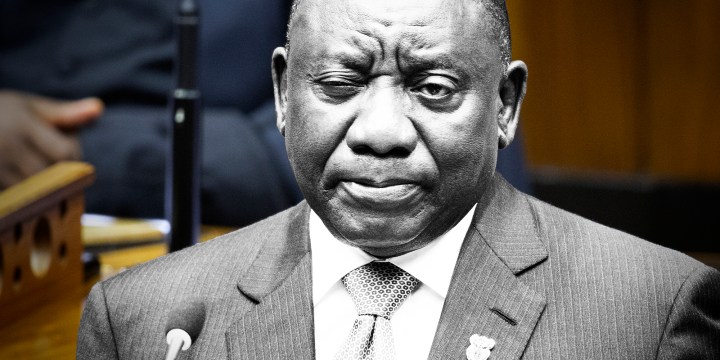BUSINESS MAVERICK
Promise Tracker: Ramaphosa’s Infrastructure Fund is yet to get off the ground

A year on, there is little to show for President Cyril Ramaphosa’s economic stimulus plan – especially his promise of launching a ‘mega’ infrastructure fund. In theory, the fund, which will draw private sector funding and skills, is noble. But protracted discussions about the role of the government, business and labour in the fund have delayed its launch.
It has been nearly one year since President Cyril Ramaphosa revealed a fiscal stimulus and economic recovery plan to yank SA from its deep economic morass. But there’s little progress to show for one of the plan’s key measures.
Emboldened by Ramaphoria, the initial burst of optimism and goodwill that came with Ramaphosa’s election as president, he announced a fiscal stimulus plan on 21 September 2018, which included the launch of a “mega” infrastructure fund.
The fund was a noble idea because it would leverage already allocated government funds and draw in private sector resources, while bringing private sector expertise to run economic growth and employment-inducing infrastructure projects.
After all, implementing infrastructure-led models is how many countries reformed their struggling economies to become global superpowers.
In helping to lift the US out of the Great Depression in the 1930s, former US president Franklin Roosevelt allocated more than $7-billion to infrastructure investments, which also resulted in the unemployed returning to work. The Asian Tigers — Hong Kong, Singapore, South Korea and Taiwan — have also followed a similar infrastructure-investment model that has seen them become highly developed and industrialised economies.
It was SA’s turn, but it appears that setting up operational structures and assembling private sector skills to support the infrastructure fund has delayed its launch. There have been many discussions between National Treasury, government departments (on all levels), the private sector and labour about their respective roles in the fund. Every party had to be appeased, which further delayed the fund’s launch.
The fund’s model
Now, about the fund. It would be led entirely by the government and funded from resources already prioritised by Treasury for infrastructure spending. In other words, there won’t be new public money going into the fund. For example, the more than R400-billion of money that has been set aside initially for the infrastructure fund over the medium term – excluding the infrastructure spend of state-owned entities (SOEs) – was already included in the budget for the next three years.
Of the R400-billion, R50-billion was to be reprioritised from somewhere in the fiscus and directed towards provincial and national roads, human settlements, water infrastructure, schools, and student accommodation. Other economic benefit infrastructure projects such as renewable energy, broadband and dams would also be explored.
The government would pull together the billions of rand allocated to its fragmented and dysfunctional infrastructure spending programme in a way that leverages additional resources from developmental finance institutions (such as the Industrial Development Corporation and Development Bank of Southern Africa), multilateral development banks (such as the World Bank and Chinese Development Bank), commercial banks and other investors.
And, important, Ramaphosa promised a dedicated infrastructure execution team in the Presidency to ensure funds are used effectively and that “shovel ready” projects are delivered on time and budget.
A year later, it is still unclear how the infrastructure fund will work.
So far, the Development Bank of Southern Africa (DBSA), a government-owned institution that funds infrastructure projects in SA and the rest of Africa to the tune of R12.2-billion (in 2018), is tasked with setting up the fund and co-ordinating private sector skills to support it. But the infrastructure fund is independent of the DBSA and is not its subsidiary.
DBSA’s head of metros, intermediate cities, and water boards, Tshepo Ntsimane, said the infrastructure fund’s platform – which will detail how the private sector will participate, outline the funding and skills required, and the pipeline of available projects to bankroll – is still being assembled. DBSA is responsible for the platform, which will be held within DBSA.
“We are also working on putting in place governance measures, so the fund is properly managed and issues such as corruption are dealt with,” Ntsimane said at a Moody’s Investor Sub-Saharan Africa Summit on Tuesday 10 September.
The platform is expected to be launched by the end of 2019.
Role of the private sector
Although the infrastructure fund will be funded mainly from public funds, Ntsimane didn’t elaborate on whether the private sector’s participation will be through a co-investing vehicle, where equity in infrastructure projects or the purchase of government bonds will be explored.
The government and DBSA have engaged with the investment and pension fund industry, which manages R5-trillion (according to a 27four Investment Managers 2018 survey), about providing skills to the Infrastructure Fund and capitalising it.
To do this, the DBSA was in talks with, among others, the Association for Savings and Investment South Africa (Asisa), which represents the majority of South Africa’s asset managers, collective investment scheme management companies and life insurance companies.
Asisa CEO Leon Campher said his members are satisfied that the fund won’t invest in SOEs, which are traditionally big infrastructure investors, by using funds raised through bond issuances. Often funds raised by SOEs through this model resulted in the money being diverted away from infrastructure projects to corruption and patronage networks.
“One of our big members told the president’s investment envoy that they want to shop and invest in South Africa. But the shelf is bare. If there are viable and well-run infrastructure projects, our members are ready to invest,” Campher told Business Maverick.
Asked if the infrastructure fund is close to being launched and fully operational, Campher said: “We are climbing Mount Everest, we are now at base camp and about to summit.”
Apart from government red tape in getting the private sector and its skills to support the infrastructure fund, the messy state of municipalities, which are at the coalface of service delivery and rolling out infrastructure projects, might stunt the full potential of the fund.
As one government bond investor said: “Municipalities are not spending sufficiently on infrastructure. I expect this to get worse going forward. Their finances are also mismanaged.”
Also, public finances are under pressure, which will make mounting mega infrastructure projects challenging. In recent years, Treasury has cut infrastructure spend to redirect money to fee-free higher education and offset low tax revenue collection. Treasury figures show that the budget for municipal infrastructure, housing, and school building was cut by R46.6-billion in the 2016/17 fiscal year, and R48.3-billion in 2018/19. BM


















 Become an Insider
Become an Insider